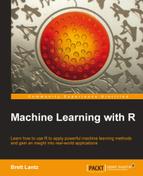Any machine learning task can be broken down into a series of more manageable steps. This book has been organized according to the following process:
- Collecting data: Whether the data is written on paper, recorded in text files and spreadsheets, or stored in an SQL database, you will need to gather it in an electronic format suitable for analysis. This data will serve as the learning material an algorithm uses to generate actionable knowledge.
- Exploring and preparing the data: The quality of any machine learning project is based largely on the quality of data it uses. This step in the machine learning process tends to require a great deal of human intervention. An often cited statistic suggests that 80 percent of the effort in machine learning is devoted to data. Much of this time is spent learning more about the data and its nuances during a practice called data exploration.
- Training a model on the data: By the time the data has been prepared for analysis, you are likely to have a sense of what you are hoping to learn from the data. The specific machine learning task will inform the selection of an appropriate algorithm, and the algorithm will represent the data in the form of a model.
- Evaluating model performance: Because each machine learning model results in a biased solution to the learning problem, it is important to evaluate how well the algorithm learned from its experience. Depending on the type of model used, you might be able to evaluate the accuracy of the model using a test dataset, or you may need to develop measures of performance specific to the intended application.
- Improving model performance: If better performance is needed, it becomes necessary to utilize more advanced strategies to augment the performance of the model. Sometimes, it may be necessary to switch to a different type of model altogether. You may need to supplement your data with additional data, or perform additional preparatory work as in step two of this process.
After these steps have been completed, if the model appears to be performing satisfactorily, it can be deployed for its intended task. As the case may be, you might utilize your model to provide score data for predictions (possibly in real time), for projections of financial data, to generate useful insight for marketing or research, or to automate tasks such as mail delivery or flying aircraft. The successes and failures of the deployed model might even provide additional data to train the next generation of your model.
..................Content has been hidden....................
You can't read the all page of ebook, please click here login for view all page.
